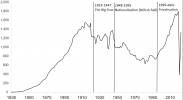I'm sure there has been a similar question in the past, but the 'number of trains' can be misleading.
Three examples that come to mind (there must be many more) -
For example - on the South Eastern suburban lines, at some times, there have been trains which are Cannon Street to Cannon Street via (for example) Crayford and Slade Green. At other times, an identical train working would have been one passenger train from Cannon Street to Crayford, then an empty train round the curve to Slade Green, and then another passenger train from Slade Green to Cannon Street.
I also have a vague memory from the late 1980s of regional railways (or was it still provincial sector then?) knitting journeys together so that there were some strange workings on the Matlock branch, like a through train (from memory) Llandudno to Matlock via Chester and Stoke on Trent, which at one stage would probably have been 3 or 4 separate trains.
And then there's the Thameslink routes where a Bedford - Brighton train may have replaced a Bedford - St Pancras train and a London Bridge - Brighton train, but the cross London bit has added to mileage and probably generated more passengers.

